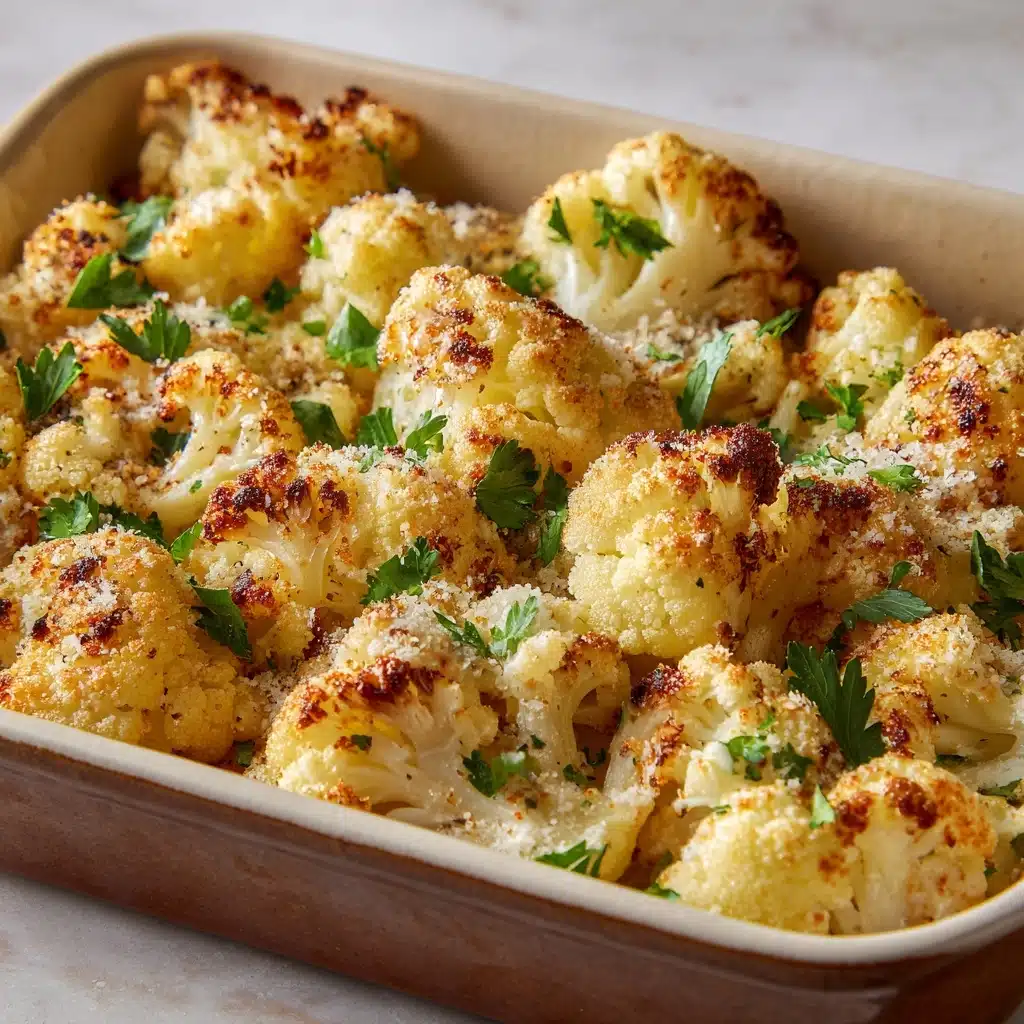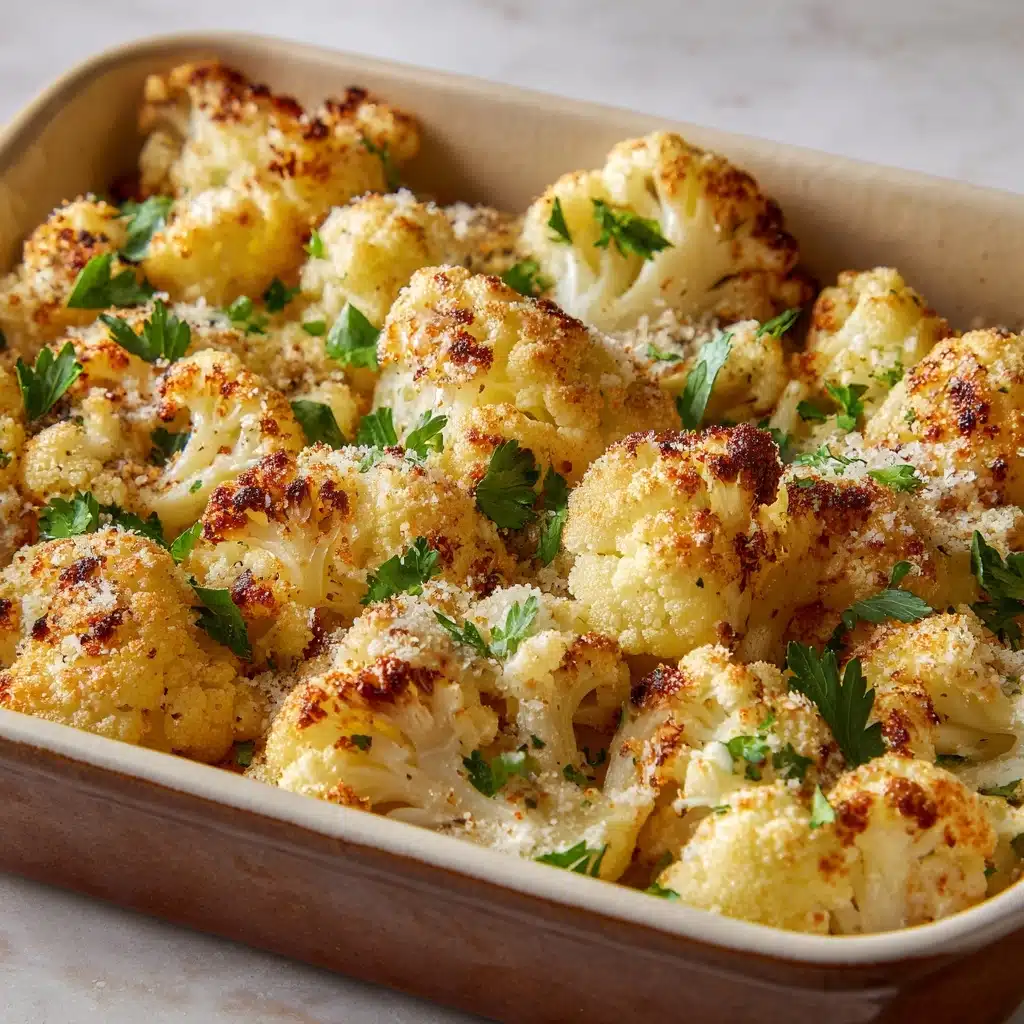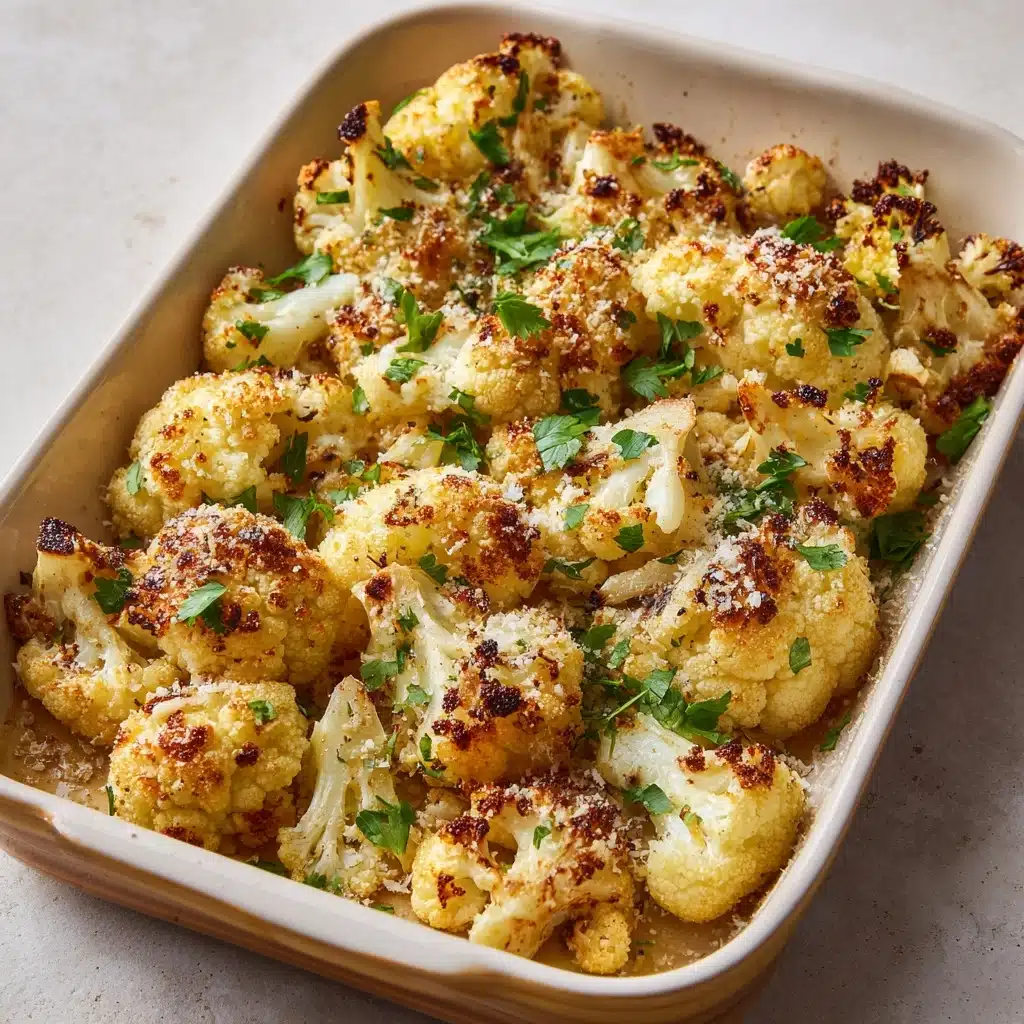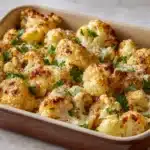Get ready to fall in love with Baked Cauliflower, a side dish that’s as irresistible as it is easy to pull off! This recipe transforms simple cauliflower florets into golden, caramelized bites with just the right hint of smoked paprika and garlic. Finished with a shower of freshly grated Parmesan and parsley, every forkful bursts with satisfying flavor and a subtle crunch. Whether you serve it alongside your weeknight favorite or make it the star of the table at your next gathering, Baked Cauliflower makes vegetables taste undeniably delicious.
Ingredients You’ll Need
The beauty of this dish lies in its simplicity. Each ingredient plays a key role, from olive oil bringing silkiness and richness, to paprika lending a smoky warmth, to a final dusting of cheese and herbs for crave-worthy flavor and color. Here’s what you’ll need for Baked Cauliflower:
- Cauliflower: Opt for a large, fresh head, broken into evenly-sized florets for consistent browning and tenderness.
- Olive Oil: This adds both moisture and helps the seasonings cling beautifully to each floret.
- Garlic: Minced fresh garlic infuses the cauliflower with bold, aromatic flavor as it roasts.
- Smoked Paprika: This smoky spice is the real game-changer, bringing depth and color to the dish.
- Salt: Just enough to highlight all the natural flavors.
- Black Pepper: Adds that little kick and rounds out the seasoning.
- Parmesan Cheese (optional): If you love a savory, salty finish, add this in the final minutes for melty magic.
- Fresh Parsley: A sprinkle of bright green parsley makes every serving feel extra fresh and inviting.
How to Make Baked Cauliflower
Step 1: Prep Your Oven and Cauliflower
Start things off by preheating your oven to 400°F (200°C); this is the sweet spot for getting that beautiful golden edge without overcooking the vegetables. While it heats up, wash and dry your cauliflower thoroughly, then cut it into bite-sized florets. Try to keep them uniform so they roast evenly—those crispy edges are what we’re after!
Step 2: Season with Flavor
In a big mixing bowl, gather your cauliflower florets and toss them with olive oil, minced garlic, smoked paprika, salt, and pepper. Give everything a good stir or toss with your hands. You want every little nook and cranny of the Baked Cauliflower to be generously coated, so don’t be shy. At this stage, feel free to add a pinch of cayenne or chili flakes if you crave extra heat.
Step 3: Roast to Perfection
Spread the seasoned florets in a single layer on a parchment-lined baking sheet—no overcrowding allowed! This ensures maximum surface area for browning. Slide the tray into your hot oven and bake for 25 to 30 minutes, giving everything a gentle toss about halfway through. When you see deep golden tips and the pieces are fork-tender, you’re almost there.
Step 4: The Final Touch
For that irresistible finish, sprinkle the Parmesan cheese over the Baked Cauliflower in the last five minutes of roasting. This gives the cheese time to melt and form a savory crust without burning. Once out of the oven, transfer to a serving dish, scatter with fresh parsley, and get ready to dig in while it’s still warm!
How to Serve Baked Cauliflower

Garnishes
A simple flourish can make all the difference. Try scattering extra fresh parsley or even chives on your finished Baked Cauliflower for vibrant color. A tiny squeeze of lemon or even a sprinkle of crushed red pepper can take the flavors up a notch. For a nutty crunch, toss on some toasted pine nuts or slivered almonds just before serving.
Side Dishes
Baked Cauliflower is a true team player at the table. Pair it with roasted chicken, grilled steak, or your favorite plant-based entrée. It’s also fabulous as part of a vegetarian spread—think alongside herby rice pilaf, garlicky sautéed greens, or a zippy Greek salad. No matter how you serve it, this dish brings warmth and vibrancy to every meal.
Creative Ways to Present
Dress this dish up for a party by piling Baked Cauliflower onto a platter with a garlicky yogurt or tahini dip on the side. For a colorful twist, roast it with a medley of cruciferous vegetables like broccoli or Romanesco. Or, make it the star by scooping over some cooked grains and topping with a bright herb sauce for an effortless grain bowl.
Make Ahead and Storage
Storing Leftovers
If you end up with extra Baked Cauliflower (lucky you!), let it cool to room temperature, then tuck it into an airtight container. It will stay fresh in the fridge for up to 3 days. The flavor actually deepens, making leftovers especially tempting for tomorrow’s lunch.
Freezing
While Baked Cauliflower is at its very best freshly roasted, you can freeze any leftovers if needed. Lay the cooled florets in a single layer on a tray to freeze individually, then transfer to a freezer-safe bag or container. They’ll keep for up to a month. When you’re ready, simply bake or sauté straight from frozen—no need to thaw!
Reheating
For the crispiest results, reheat leftover Baked Cauliflower in a 400°F (200°C) oven for about 10 minutes, or until warmed through. Microwaving works in a pinch, though the texture will be softer. Try tossing the reheated florets in a hot skillet with a splash of olive oil to revive their golden edges.
FAQs
Can I make Baked Cauliflower vegan?
Absolutely! Just skip the Parmesan cheese or substitute it with nutritional yeast for that same umami flavor, and you’ll have a completely plant-based dish everyone can enjoy.
How do I get extra-crispy edges?
The trick is to arrange the cauliflower in a single, uncrowded layer on your baking sheet. Overcrowding steams the florets instead of roasting them crispy, so use two sheets if needed. Also, high heat and tossing halfway through help maximize caramelization.
Can I use frozen cauliflower?
Yes, you can, but thaw and dry the florets thoroughly first. The results might be a bit softer and less crisp, but they’ll still be delicious, especially with the bold smoked paprika and garlic flavors.
What other vegetables work with this method?
Broccoli, Romanesco, and even Brussels sprouts love this same treatment! Mixing cauliflower with similar-sized florets of other cruciferous veggies lets you play with colors and flavors, making the side even more interesting.
Is this recipe suitable for low-carb and gluten-free diets?
Yes, Baked Cauliflower is naturally low in carbs and is completely gluten-free—just double-check any added toppings. It’s a wonderful fit for anyone looking for lighter, irresistibly satisfying side dishes.
Final Thoughts
If you’ve never tried Baked Cauliflower before, let this be the recipe that wins you over. With its blissfully simple prep, crave-worthy flavor, and endless serving options, it’s the kind of dish you’ll come back to all year long. Gather your ingredients and treat yourself—you’ll be so glad you did!
PrintBaked Cauliflower Recipe
A simple and flavorful recipe for baked cauliflower that makes a delicious side dish. Tender cauliflower florets are seasoned with garlic, smoked paprika, and Parmesan cheese, then baked to perfection.
- Prep Time: 10 minutes
- Cook Time: 30 minutes
- Total Time: 40 minutes
- Yield: 4 servings 1x
- Category: Side Dish
- Method: Baking
- Cuisine: American
- Diet: Vegetarian
Ingredients
Main Ingredients:
- 1 large head of cauliflower, cut into florets
- 3 tablespoons olive oil
- 2 cloves garlic, minced
- 1 teaspoon smoked paprika
- 1/2 teaspoon salt
- 1/2 teaspoon black pepper
Optional Garnish:
- 1/4 cup grated Parmesan cheese
- 1 tablespoon chopped fresh parsley for garnish
Instructions
- Preheat Oven: Preheat oven to 400°F (200°C) and line a baking sheet with parchment paper.
- Prepare Cauliflower: In a large bowl, toss the cauliflower florets with olive oil, garlic, smoked paprika, salt, and pepper until evenly coated.
- Bake: Spread the cauliflower in a single layer on the baking sheet. Bake for 25–30 minutes, tossing halfway through, until tender and lightly golden.
- Finish and Serve: Optionally, sprinkle with Parmesan cheese during the last 5 minutes of baking. Garnish with fresh parsley and serve warm.
Notes
- Add a pinch of cayenne pepper or chili flakes for heat.
- Use nutritional yeast instead of Parmesan for a dairy-free option.
- This recipe also works well with broccoli or a mix of cruciferous vegetables.
Nutrition
- Serving Size: 1 cup
- Calories: 110 kcal
- Sugar: 3 g
- Sodium: 280 mg
- Fat: 8 g
- Saturated Fat: 1.5 g
- Unsaturated Fat: 6.5 g
- Trans Fat: 0 g
- Carbohydrates: 8 g
- Fiber: 3 g
- Protein: 3 g
- Cholesterol: 0 mg




